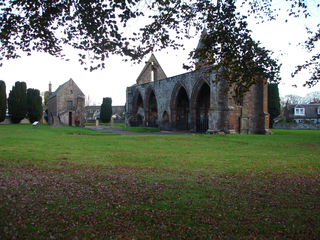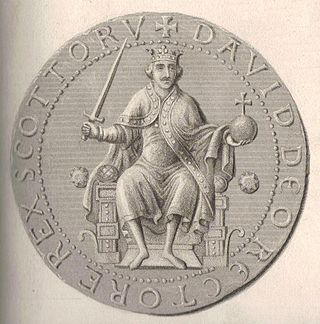Related Research Articles
Mormaer Beth is a name of a Mormaer mentioned in an unreliable charter granted to Scone Priory, later Scone Abbey, by king Alexander I of Scotland.

The Bishop of St. Andrews was the ecclesiastical head of the Diocese of St Andrews in the Catholic Church and then, from 14 August 1472, as Archbishop of St Andrews, the Archdiocese of St Andrews.
Cormac, Bishop of Dunkeld is the earliest recorded Bishop of Dunkeld in the 12th century, although he was not the first bishop of Dunkeld. It is possible, that he was the first bishop of Dunkeld distinct from the abbot, but there is no evidence for this. He appears in two rather doubtful charters of King Alexander I of Scotland, in several charters of King David I of Scotland and in the Gaelic notitiae on the Book of Deer, rendering a floruit of on or before the year 1114, to on or after the year 1131. The last source calls him "Cormac escob Dúno Callenn", Cormac bishop of Dunkeld".
Gregoir, Bishop of Dunkeld, served as Bishop of Dunkeld in the middle of the 12th century. Before being raised to the bishopric by King David I of Scotland, he was the abbot of Dunkeld. King David entrusted certain lands to Gregory, who was to hold them until there were canons on the island of St. Colme's Inch, a charge accomplished before 1169. The lands so entrusted included the island itself, “Kincarnathar”, and Donibristle. Gregory appears in a great number of charters dating to the reigns of David I and Máel Coluim IV of Scotland, the earliest of which may date to 1135, although 1146 is the first firm date, when he appears alongside Bishop Andreas of Caithness in the Gaelic notitiae on the Book of Deer. He is not the last Gaelic bishop of the diocese, but his death marks the end of dominance of the bishopric by principally Gaelic-speaking bishops.

The Bishop of Ross was the ecclesiastical head of the Diocese of Ross, one of Scotland's 13 medieval bishoprics. The first recorded bishop appears in the late 7th century as a witness to Adomnán of Iona's Cáin Adomnáin. The bishopric was based at the settlement of Rosemarkie until the mid-13th century, afterwards being moved to nearby Fortrose and Fortrose Cathedral. As far as the evidence goes, this bishopric was the oldest of all bishoprics north of the Forth, and was perhaps the only Pictish bishopric until the 9th century. Indeed, the Cáin Adomnáin indicates that in the reign of Bruide mac Der Ilei, king of the Picts, the bishop of Rosemarkie was the only significant figure in Pictland other than the king. The bishopric is located conveniently close to the heartland of Fortriu, being just across the water from Moray.
The Bishop of Moray or Bishop of Elgin was the ecclesiastical head of the Diocese of Moray in northern Scotland, one of Scotland's 13 medieval bishoprics. If the foundation charter of the monastery at Scone is reliable, then the Bishopric of Moray was in existence as early as the reign of King Alexander I of Scotland (1107–1124), but was certainly in existence by 1127, when one Gregoir ("Gregorius") is mentioned as "Bishop of Moray" in a charter of king David I of Scotland. The bishopric had its seat at Elgin and Elgin Cathedral, but was severally at Birnie, Kinneddar and as late as Bishop Andreas de Moravia at Spynie, where the bishops continued to maintain a palace. The Bishopric's links with Rome ceased to exist after the Scottish Reformation, but continued, saving temporary abolition between 1638 and 1661, under the episcopal Church of Scotland until the Revolution of 1688. Episcopacy in the established church in Scotland was permanently abolished in 1689. The Bishops fortified seat for over 500 years was at Spynie Palace.
Mac Bethad is the first recorded High Medieval Bishop of Ross, a See then located at Rosemarkie.
Samson of Brechin is the first known Bishop of Brechin. He appears as a witness in a charter granted by King David I of Scotland to the community of Deer, recorded in the notitiae in the margins of the Book of Deer. The charter dates to some point between the years 1140 and 1153, although it can probably be pinned down to the year 1150. There certainly was a bishopric of Brechin in 1150, as there exists another charter of King David's, this time granted to the bishop (unnamed) and Céli Dé of Brechin. It is known that Samson was still bishop in the reign of King Máel Coluim IV (1153–1165), appearing as a witness as late as 1165 in a charter of Richard, Bishop of St. Andrews.
Robert of Scone was a 12th-century bishop of Cell Rígmonaid. Robert's exact origins are unclear. He was an Augustinian canon at the Priory of St. Oswalds, at Nostell. His French name indicates a Norman rather than an Anglo-Saxon origin, but as he was likely born in the later 11th century, this may be due merely to the acculturation of his parents.

The Davidian Revolution is a name given by many scholars to the changes which took place in the Kingdom of Scotland during the reign of David I (1124–1153). These included his foundation of burghs, implementation of the ideals of Gregorian Reform, foundation of monasteries, Normanisation of the Scottish government, and the introduction of feudalism through immigrant Norman and Anglo-Norman knights.

Historical treatment of David I and the Scottish church usually emphasises King David I of Scotland's pioneering role as the instrument of diocesan reorganisation and Norman penetration, beginning with the bishopric of Glasgow while David was Prince of the Cumbrians, and continuing further north after David acceded to the throne of Scotland. As well as this and his monastic patronage, focus too is usually given to his role as the defender of the Scottish church's independence from claims of overlordship by the Archbishop of York and the Archbishop of Canterbury.
Edward [Ēadweard, Eadward, Édouard, Étbard] was a 12th-century prelate based in Scotland. He occurs in the records for the first time as Bishop of Aberdeen in a document datable to some point between 1147 and 1151. His immediate predecessor, as far as the records are concerned, was Bishop Nechtán. The latter can be shown to have been active at least between 1131 and 1132, and possibly as late as 1137. Edward's accession must have occurred, then, sometime between 1131 and 1151, with a date after the 1130s more likely than not.
William was a 12th-century prelate based in the Kingdom of Scotland. He occurs in the records for the first time as Bishop of Moray in 1152 x 24 May 1153, late in the reign of King David I of Scotland (1124–53) witnessing a grant from that monarch of the church of Clackmannan to the Abbot of Cambuskenneth. The precise date of his accession is unknown but was probably in 1152.
Symeon is the second known Bishop of Ross in the 12th century. His predecessor Mac Bethad occurred as bishop in a document datable between 1127 and 1131.
Gregoir [Gregory, Gregorius] is the third known 12th century Bishop of Ross, an episcopal see then based at Rosemarkie.
Alexander Stewart was a 14th-century Scottish bishop. Probably from Menteith, he appears in the sources from the first half of the 1340s, possessing a university degree and holding the position of Archdeacon of Ross. He was active at the papal curia in the second half of the decade as a papal chaplain and administrator, before being provided as Bishop of Ross in 1350, a position he held until his death in 1371.
Alexander de Kylwos – written alternatively as Frylquhous, Kylquos, and a variety of other forms – was a Scottish churchman and prelate active in the second half of the 14th century. He is known to have held senior positions in three bishoprics, and senior offices in two, before being elected and appointed Bishop of Ross in 1371. Though his episcopate is relatively obscure, he seems to have spent almost all of it inside or around his province, was closely associated with William III and Euphemia I, successive rulers of Ross, and was an associate of the famous Alexander Bur, Bishop of Moray, during the latter's struggle with Alexander Stewart, the son of the King later known by the nickname "Wolf of Badenoch".
Simon is the third known 12th century Bishop of Dunblane. Nothing is known of Simon's background as there are numerous Simons in Scotland in this period, both native and foreign. There is a Symon de Liberatione who witnessed a charter of King William the Lion and whom Watt and Murray suggested may have been the later Bishop of Dunblane, while there was in the same decade a local landholder and ecclesiastical patron in the diocese of Dunblane called Simón son of Mac Bethad.
Nechtan of Aberdeen is the first Bishop of Aberdeen after the seat of the bishopric had been moved to Aberdeen from Mortlach. The only contemporary sources for Bishop Nechtan are charters; he appears as "Nectan escob Abberdeon" in a Gaelic charter recorded in the notitiae on the Book of Deer, a charter which explicitly dates to "the eighth year of the reign of David", that is, 1131. He also appears in a charter granted to him by King David I of Scotland, a charter which the modern editor dates to 1137.
Thor of Tranent, also known as Thor, son of Sveinn or Thor, son of Swain, Lord of Tranent and Sheriff of Lothian, was a landlord and chieftain active in Lothian in the reign of King David I of Scotland. He is attested in a large number of charters during King David's reign in Lothian, both as a charter witness on charters granted by other patrons and on charters he himself issued. His name appears either as Thor son of Sveinn or "Thor of Tranent", the latter appellation deriving from his ownership of the "barony" of Tranent, East Lothian, lands including a wide area around the modern town, including, for instance, Prestonpans.
References
- Dowden, John, The Bishops of Scotland, ed. J. Maitland Thomson, (Glasgow, 1912)
- Lawrie, Sir Archibald, Early Scottish Charters Prior to A.D. 1153, (Glasgow, 1905)
- Veitch, Kenneth, ""Replanting Paradise":Alexander I and the Reform of Religious Life in Scotland", in The Innes Review, 52, (Autumn,2001), pp. 136–166